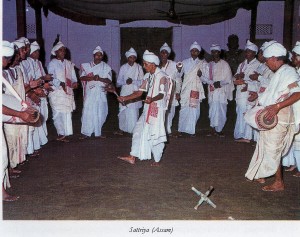In 16th century, Shankaradeva, a devout Vaishnava and a creative genius of Assam shaped a stylized theatre to give vent to his spiritual feelings. He wrote several Ankianats i.e. one act plays, the performance of which is called Bhawana, literally meaning contemplation or meditation. The Ankianats were performed in the Vaishnava monasteries called Sattra. In Bhawana performance, female roles are played by boys. The performance includes several solo dance passages which are performed by the boys. When these solo passages are performed not as a part of the drama but independent presentation, they are called Sattriya dance. The dance is accompanied by singing and percussion music of Khol, the drum with two faces much like the Pung of Manipur, and Manjira, small cymbals.

The counterpart in Andhra Pradesh is the Kuchipudi dance. Kuchipudi is actually a tradition of dance drama which has solo dance passages lie the Bhawana. When the solo passages are presented independently it is also called Kuchipudi. Since it has been accepted as a classical style of dance, it is not discussed here. In fact, both the Gotipua dance and the Sattriya dance are more sophisticated than most of the folk dances and have classical elements like the dance of Maibis of Manipur.
